India’s economic dialogue often centers on its trade interactions with China, given the notable trade disparity between the two nations. Understanding and addressing this dependency is crucial for India’s economic sovereignty and resilience.
Import Dynamics
In the fiscal year 2023-24, India’s imports from China amounted to approximately $101.7 billion, contrasting sharply with its exports to China, which totaled only $16.7 billion. This stark imbalance underscores India’s heavy reliance on Chinese imports, prompting inquiries into the nature, critical dependencies, and extent of this reliance.
Composition of Imports
Contrary to common assumptions, India’s dependency does not revolve mainly around consumer goods from China but rather intermediate and capital goods crucial for its industrial and manufacturing sectors. Analyzing the composition of these imports unveils critical areas of dependence and prompts strategic measures to fortify self-reliance.
Key Inquiries
Addressing pivotal questions is imperative to devise effective strategies:
1. Reasons for High Imports: Understanding the factors contributing to India’s substantial import volume from China is essential for devising targeted solutions.
2. Import Content: Identifying the specific goods imported from China and assessing their criticality is crucial for reducing reliance on Chinese imports.
3. Strategic Mitigation: Exploring long-term measures to decrease India’s dependence on Chinese imports and learning from strategies adopted by other nations is vital for economic resilience.
Economic Impact Assessment
To assess the economic ramifications of imports from China, particularly concerning their end-use, the Broad Economic Categories (BEC) classification proves instrumental. Unlike the harmonized system (HS), which categorizes products numerically, BEC classifies goods based on their primary economic function or end-use, facilitating a more nuanced analysis of import data.
Critical Observations
Observations gleaned from the data underscore several trends:
1. Import Share: Chinese imports constitute 15% of India’s total imports, with intermediate and capital goods comprising a significant portion. Understanding these trends is crucial for strategic planning.
2. Shifts in Import Trends: While consumer goods imports are declining, intermediate goods imports are rising steadily. Identifying and addressing these shifts is essential for maintaining a balanced trade portfolio.
Global Trade Dynamics
India is not alone in its reliance on Chinese imports. Many leading economies also depend heavily on China for various imports, leading to an upward trajectory in China’s exports to these nations. Understanding global trade dynamics is essential for devising effective trade policies.
Strategic Imperatives
Given the escalating trade deficit with China, it is imperative for Indian policymakers and industries to reevaluate import strategies. This entails fostering more resilient and diversified supply chains to mitigate economic risks and bolster domestic industries.
Impact on Industrial Sectors
India’s dependence on Chinese imports spans multiple sectors, including electronics, machinery, chemicals, pharmaceuticals, textiles, automobiles, and more. Notably, Chinese imports constitute a substantial portion of India’s imports in critical sectors such as electronics and machinery. Assessing the impact on these sectors is essential for devising targeted interventions.
Call for Action
Addressing this import dependency necessitates concerted efforts:
1. Diversification: Actively seeking alternative trading partners beyond China can mitigate risk and enhance negotiating leverage. Exploring new markets and fostering trade partnerships is essential for diversifying India’s import sources.
2. Boosting Domestic Production: Investing in research, development, and infrastructure can foster domestic production of critical goods, reducing reliance on imports. Strengthening the ‘Make in India’ initiative and promoting indigenous manufacturing capabilities are crucial steps in this direction.
3. Promoting Innovation: Establishing technology parks and fostering collaboration between academia and industry can spur innovation and indigenous production. Investing in research and development and creating an enabling environment for innovation is essential for enhancing India’s competitiveness in the global market.
Conclusion
India’s import dependence on China poses multifaceted challenges but also presents opportunities for strategic recalibration. By adopting a holistic approach that prioritizes diversification, domestic production, and innovation, India can navigate these challenges and emerge as a more self-reliant and resilient economy in the global trade landscape. This calls for collaborative efforts between the government, industries, and other stakeholders to chart a sustainable path forward.
ALSO READ: How India, largest economy of the world once, got sudden decline and rise?
